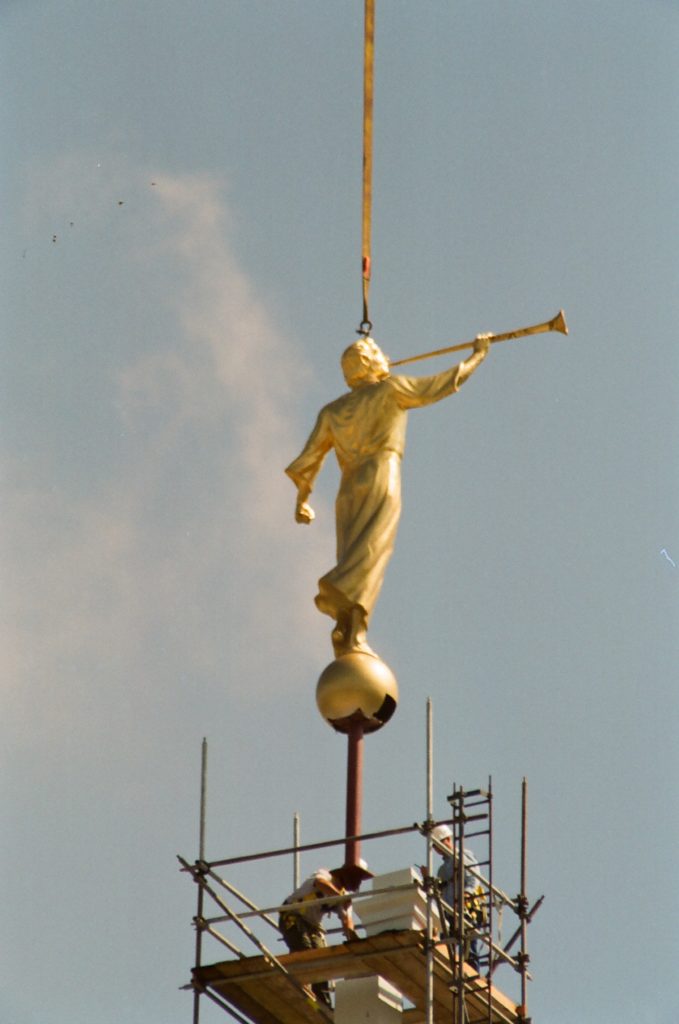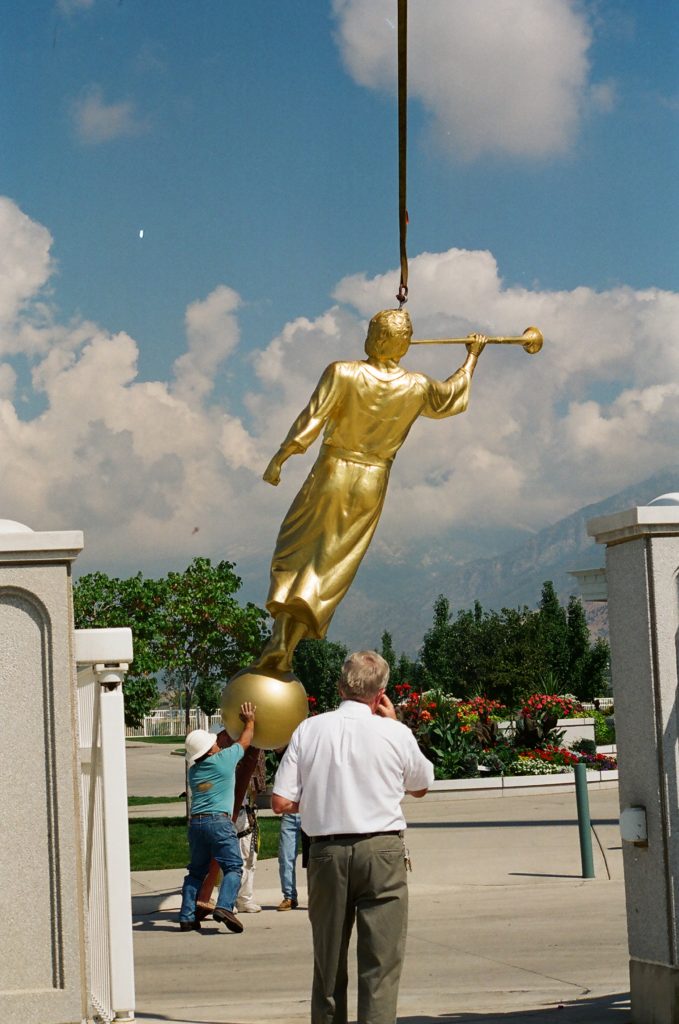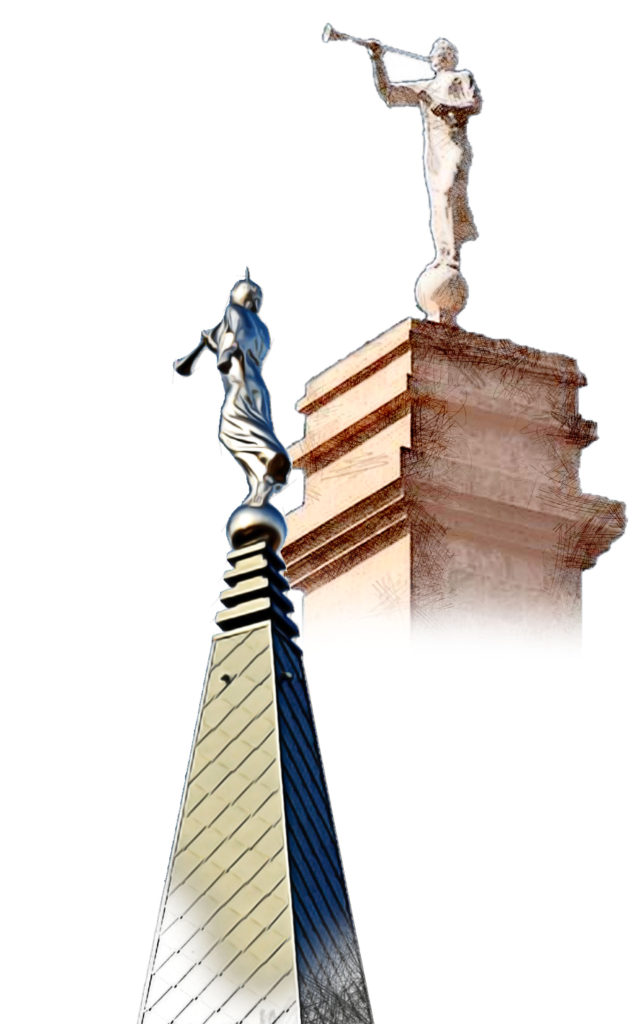
Gold Leaf and Angel Replacements
Gold Leafing a Statue
To make gold leaf, a piece of gold is rolled and flattened multiple times until it is extremely thin and fragile. A Piece of gold the size of a US 50 cent piece, when turned to leaf, can cover about an acre of land.[1]Joyce “Angel Moroni Statue Lifted into Place,” bctemple.blogspot.com, 21 July 2011. Accessed 11 June 2015 When gold is that thin, it does not take much to cover the whole statue.
Regild and Replace
The gold leaf is a very effective covering for a statue. In Europe, leafing has been used on statues for centuries. In many cases, gold leaf can be more resilient and longer lasting than paint.[2]Interview by Brian Olson of Aaron Allen, painter, gilder, 10 August 2019
Unfortunately, nothing lasts forever, and despite the resiliency of what is essentially a solid coating of metal, eventually replacements must be made. The statues are placed in the most extreme of weathers and exposed to air pollution of all kinds. While the gold leaf is sealed after placement to further protect it, the leaf does eventually fade, tarnish or flake off.
Statues are refurbished one of two ways: Replacement, or Refinished in place.
Statue Replacement
For the statues damaged by lightning, smaller temples, or statues difficult to reach even with scaffolding, the statues will typically be replaced with another of the same model every 15 or so years. The old statue will be cleaned, refurbished, and sent on to another temple in a kind of Moroni statue rotation. For example, a statue that is being placed atop the Raleigh North Carolina Temple may have come off the Birmingham Alabama Temple most recently.[3]“Angel Moroni Statue Replaced on Raleigh Temple,” LDSColdsboroStakeNews.wordpress.com, 22 May 2014. Then, the statue from Raleigh would be sent to Salt Lake, where it would be refurbished and sent back out to be swapped for the statue atop another temple.
Refinished in Place
On the larger temples the statue will often be refurbished in place. On temples that use the older non-fiberglass statues, they are almost always refurbished in place, and usually less frequently. These “in-place” refurbishing will sometimes coincide with a cleaning and refurbishing of the temple exterior as well.
In Search of a longer lasting gold
The gilding on the statue is beautiful. It is a single layer of a single element, with a sealing coat on it. It is resilient, but under the strain of frequent lightning strikes, acid rain, and bird poop, it does break down. Paint on the other hand, is a vehicle solution containing pigments and binders. It is multi part, and as such, breaks down much quicker than the single part crystalline metal structure of gold leaf. [4]Aaron Allen While it lasts longer than paint, and is ultimately less expensive as a consequence, it should come as no surprise that efforts have been made to find an alternative. One such effort, for example, was the creation of the white statues in 1999. Other efforts involved using paint instead of leaf.
Wallgren’s Tests
Creation of a fiberglass statue is not always successful. Occasionally, upon removing the fiberglass from the molds, a statue segment will fail to come out in one piece. During his days running his studio, LaVar Wallgren would save these sections of broken statues for a very specific purpose.
Anytime a salesman would come to down with ‘the newest, greatest replacement for gold leaf,’ Wallgren would buy a quart. Then he would paint one of his fiberglass segments, and toss the pieces up on the roof. Anytime the Church came to him with a replacement for gold, he would paint a piece and toss it up on the roof as well.[5]Aaron Allen
The end result was a real-world test lab for gold leaf alternatives right above his own studio. The Church was welcome at any time to come on down and examine the effectiveness of these latest and greatest alternatives. The fact that 15 years after Wallgren’s passing Gold leaf is still being used on the statues should be ample indication of how well these miracle alternatives hold up to the real thing.[6]Aaron Allen
Vernal and Reno
Mike Enfeild worked for the Church in managing temple construction. In 1996 he had two busts of the Prophet Joseph Smith made from foam He then asked Lavar Wallgren to gold leaf one, and finish the other in gold automotive paint.
After seeing the two busts, the decision was made to try one statue in the gold paint and use it on the Vernal Temple. The resulting statue, placed 26 September 1996, looked good on sunny days, but looked brown when it was overcast. The decision was made shortly thereafter to replace the statue with a traditionally gold leafed one instead.


The following year architect Lee Gray, who was working on the Conference Center came into Enfeild’s office and asked about the two gold busts. Enfeild explained their purpose and the test with painting a statue. Gray liked the auto body paint concept and used it on the organ pipes in the new Conference Center.[7]Mike Enfield, email to Marvin Quist, 15 February 2017
When it was time to make a statue for the Reno Temple, the decision was made again to use the automotive paint (likely because of the high winds and dust storms in the area.) The Reno statue, placed in early 2000, is still on the temple today and as recently as 2014 still had the gold automotive paint. On 29 September 2014 the painted statue was removed, a new gold leafed replica of the same model was slid into place, and the painted statue was moved into storage.[8]Temple Engineer phone interview, Marvin Quist, 13 August 2019
Mount Timpanogos
Another attempt at finding a replacement was made on the Mount Timpanogos temple in 2003. The temple was undergoing an exterior cleaning, with scaffolding all over the outside and up the spire.
The Angel statue was already in need of replacement, and the decision was made to run a temporary paint test on it before it was replaced. The bottom half of the statue was painted with a high-quality gold paint, then left to weather while the temple exterior was cleaned.
The end result held up well to the weather. However, it was decided that it had too much of a green cast to it, and the experiment was
discontinued. In photos of the old statue being removed (previous page,) the bottom half of the statue is a darker color than the rest of the statue. As the rest of the statue is missing most of the Gold leaf due to weather, the new paint would have been much darker than traditional gold leaf.[9]Interview by Brian Olson of Temple Engineer on Site during the statue swap out, September 2002.
Trying it Without Gold
To date, there have been 2 attempts to reduce the cost of the statue by doing away with the gold color all together. The advantage of this method of cost reduction is that you don’t have to worry about how much the alternative does or does not look like Gold. It can have drawbacks, as the first attempt shows.
Monticello Utah
LaVar Wallgren was tasked with coming up with a new statue for President Hinckley’s new small temples in 1997. His statue was unique in several of its features, but the most striking change was that this new, smaller, cheaper statue was white.
The idea was interesting. Just like there is no rule that the temple must have an angel statue atop its peak, nowhere does it say that the statue, when included, must be gold colored. Gold produces vibrant color, and the reflective metal can shift looks through the day as shadows and highlights dance across the surface. Color can change as it reflects and absorbs color from its environments.
It also can look good no matter how bright or dull the sunlight is. It is this last point that proved to be an issue for the white state. Only one was placed, atop the Monticello Temple, on 14 May 1998.
Once the statue was placed, it did not take long to find that the statue did not reflect light the same way the gold leaf does. What would have been deep shadows and bright highlights with a gilded statue was more flat and even across the face of the whole statue. On cloudy days, the white was as effective as camouflage, causing the statue to disappear in a sense from view entirely.
As a consequence, the first white statue was also the last. It was replaced with a larger, gilt statue on 25 May 1999, one year and 11 days after it was placed.

Abidjan Ivory Coast
While not explicitly done as a cost-cutting measure, one other non-gilt statue has been placed in the history of the statues. And that one was more recently. On 15 April 2021 an Angel Moroni statue was placed atop the spire of the Abidjan Ivory Coast Temple. Unlike any other statue that had been placed before, it was Silver.
There are many ways to make fiberglass silver. Besides paint, fiberglass can be chromed. There are also various methods of metal leaf that have a silver appearance, such as silver and aluminum.
With the Abidjan Statue, the temple is covered in Palladium Leaf. Palladium is more resilient than Gold Leaf. It should hold up better to the elements than gold leaf. It is also a one-off thing. No other silver statues are currently planned. It was felt that the Gold would be too flashy for the setting and design of the temple, so the silver color alternative was chosen instead.[10]Interview with Private Source, Marvin Quist, 25 January 2022
Chapter 5 Navigation
References
| ↑1 | Joyce “Angel Moroni Statue Lifted into Place,” bctemple.blogspot.com, 21 July 2011. Accessed 11 June 2015 |
|---|---|
| ↑2 | Interview by Brian Olson of Aaron Allen, painter, gilder, 10 August 2019 |
| ↑3 | “Angel Moroni Statue Replaced on Raleigh Temple,” LDSColdsboroStakeNews.wordpress.com, 22 May 2014. |
| ↑4, ↑5, ↑6 | Aaron Allen |
| ↑7 | Mike Enfield, email to Marvin Quist, 15 February 2017 |
| ↑8 | Temple Engineer phone interview, Marvin Quist, 13 August 2019 |
| ↑9 | Interview by Brian Olson of Temple Engineer on Site during the statue swap out, September 2002. |
| ↑10 | Interview with Private Source, Marvin Quist, 25 January 2022 |
